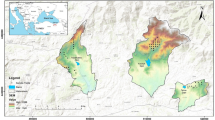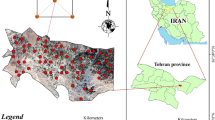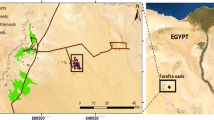Abstract
Digital soil mapping relies on field observations, laboratory measurements and remote sensing data, integrated with quantitative methods to map spatial patterns of soil properties. The study was undertaken in a hilly watershed in the Indian Himalayan region of Mandi district, Himachal Pradesh for mapping soil nutrients by employing artificial neural network (ANN), a potent data mining technique. Soil samples collected from the surface layer (0–15 cm) of 75 locations in the watershed, through grid sampling approach during the fallow period of November 2015, were preprocessed and analysed for various soil nutrients like soil organic carbon (SOC), nitrogen (N) and phosphorus (P). Spectral indices like Colouration Index, Brightness Index, Hue Index and Redness Index derived from Landsat 8 satellite data and terrain parameters such as Terrain Wetness Index, Stream Power Index and slope using CartoDEM (30 m) were used. Spectral and terrain indices sensitive to different nutrients were identified using correlation analysis and thereafter used for predictive modelling of nutrients using ANN technique by employing feed-forward neural network with backpropagation network architecture and Levenberg–Marquardt training algorithm. The prediction of SOC was obtained with an R2 of 0.83 and mean squared error (MSE) of 0.05, whereas for available nitrogen, it was achieved with an R2 value of 0.62 and MSE of 0.0006. The prediction accuracy for phosphorus was low, since the phosphorus content in the area was far below the normal P values of typical Indian soils and thus the R2 value observed was only 0.511. The attempts to develop prediction models for available potassium (K) and clay (%) failed to give satisfactory results. The developed models were validated using independent data sets and used for mapping the spatial distribution of SOC and N in the watershed.













Similar content being viewed by others
References
Abdollahzadeh A, Mukhlisin M, El Shafie A (2011) Predict soil erosion with artificial neural network in Tanakami (Japan). WSEAS Trans Comput 10:51–60
Anagu I, Ingwersen J, Utermann J, Streck T (2009) Estimation of heavy metal sorption in German soils using artificial neural networks. Geoderma 152:104–112
Atkinson PM, Tatnall ARL (1997) Neural networks in remote sensing. Int J Remote Sens 18:699–709
Ayoubi S, Shahri AP, Karchegani PM, Sahrawat KL (2011) Application of artificial neural network (ANN) to predict soil organic matter using remote sensing data in two ecosystems. In: Atazadeh I (ed) Biomass and remote sensing biomass. In Tech, Rijeka. https://doi.org/10.5772/18956
Bagheri Bodaghabadi M, Martínez-Casasnovas JA, Salehi MH, Mohammadi J, Esfandiarpoor Borujeni I, Toomanian N, Gandomkar A (2015) Digital soil mapping using artificial neural networks and terrain-related attributes. Pedosphere 25(4):580–591
Banu Ikizler S, Aytekin M, Vekli M, Kocabao F (2010) Prediction of swelling pressures of expansive soils using artificial neural networks. Adv Eng Softw 41:647–655
Barnes EM, Baker MG (2000) Multispectral data for mapping soil texture: possibilities and limitations. Appl Eng Agric 16(6):731
Behrens T, Forster H, Scholten T, Steinrücken U, Spies ED, Goldschmitt M (2005) Digital soil mapping using artificial neural networks. J Plant Nutr Soil Sci 168:21–33
Bouyoucos GJ (1962) Hydrometer method improved for making particle size analysis of soils. Agron J 54:464–465
Burrough PA (1986) Principles of geographical information systems for land resources assesment. Clarendon Press, Oxford
Chiang YM, Chang LC, Chang FJ (2004) Comparison of static-feedforward and dynamic-feedback neural networks for rainfall-runoff modelling. J Hydrol 290:297–311
Dai PF, Qigang Z, Zhiqiang LV, Xuemei W, Gangcai L (2014) Spatial prediction of soil organic matter content integrating artificial neural network and ordinary kriging in Tibetan Plateau. Ecol Indic 45:184–194
Demuth H, Beale M (2004) Neural network toolbox, for use with MATLAB. The Math Works Inc., Natick
FAO-ISRIC (1990) Guidelines for soil profile description, 3rd edn, Rome
Forkuor G, Hounkpatin OKL, Welp G, Thiel M (2017) High resolution mapping of soil properties using remote sensing variables in south-western Burkina Faso: a comparison of machine learning and multiple linear regression models. PLoS ONE 12(1):e0170478. https://doi.org/10.1371/journal.pone.0170478
Gomez C, Rossel R, McBratney AB (2008) Soil organic carbon prediction by hyperspectral remote sensing and field Vis–NIR spectroscopy: an Australian case study. Geoderma 146(3):403–411
Hahn C, Gloaguen R (2008) Estimation of soil types by non-linear analysis of remote sensing data. Nonlinear Processes Geophys 15(1):115–126
Haykin S (1999) Neural networks and learning machines, 3rd edn. Prentice Hall, Englewood Cliffs
Hengl T, Heuvelink GBM, Stein A (2004) A generic framework for spatial prediction of soil variables based on regression-kriging. Geoderma 120:75–93
Jackson ML (1973) Soil chemical analysis. Prentice Hall, New Delhi
Jenson SK (1991) Applications of hydrological information automatically extracted from digital elevation models. Hydrol Process 5:31–44
Keshavarzi A, Sarmadian F, Omran EE, Iqbal M (2015) A neural network model for estimating soil phosphorus using terrain analysis. Egypt J Remote Sens Space Sci 18:127–135
Lagacherie P, McBratney AB, Voltz M (2007) In digital soil mapping: an introductory perspective. Elsevier, Amsterdam, pp 389–399
Lakzian A, Fazeli Sangani M, Astaraei A, Fotovat A (2013) Estimation and mapping soil organic carbon content using terrain analysis (case study: Mashhad, Iran). J Water Soil 27(1):180–192 (In Persian)
Malone BP, Jha SK, Minasny B, McBratney AB (2016) Comparing regression-based digital soil mapping and multiple-point geostatistics for the spatial extrapolation of soil data. Geoderma 262:243–253
McBratney AB, Mendonca Santos ML, Minasny B (2003) On digital soil mapping. Geoderma 117:3–52
McKenzie NJ, Ryan PJ (1999) Spatial prediction of soil properties using environmental correlation. Geoderma 89:67–94
McKenzie NJ, Gessler PE, Ryan PJ, O’Connell DA (2000) The role of terrain analysis in soil mapping. In: Wilson JP, Gallant JC (eds) Terrain analysis: principles and applications. Wiley, New York
Minasny B, McBratney AB, Malone BP, Wheeler I (2013) Digital mapping of soil carbon. Adv Agron 118:1–47
Moore ID, Gesslewr PE, Nielsen GA, Peterson GA (1993) Soil attribute prediction using terrain analysis. Soil Sci Soc Am J 57:443–452
Mulder VL, de Bruin S, Schaepman ME, Mayr TR (2011) The use of remote sensing in soil and terrain mapping—a review. Geoderma 162:1–19
Murphy J, Riley JP (1962) A modified single solution method for the determination of phosphate in natural waters. Anal Chim Acta 27:31–36
Pilevar Shahri AR, Ayoubi S, Khademi H (2011) Comparison of artificial neural network (ANN) and multivariate linear regression (MLR) models to predict soil organic carbon using digital terrain analysis (case study: Zargham Abad Semirom, Isfahan Province). J Water Soil 24(6):1151–1163 (In Persian)
Sachs J, Remans R, Smukler S, Winowiecki L, Andelman SJ, Cassman KG et al (2010) Monitoring the world’s agriculture. Nature 466(7306):558–560. https://doi.org/10.1038/466558a
Scudiero E, Skaggs TH, Corwin DL (2014) Regional scale soil salinity evaluation using Landsat 7, western San Joaquin Valley, California, USA. Geoderma Reg 2:82–90
Scull P, Franklin J, Chadwick OA, McArthur D (2003) Predictive soil mapping: a review. Prog Phys Geogr 27:171–197
Shabani A, Norouzi M (2015) Predicting cation exchange capacity by artificial neural network and multiple linear regression using terrain and soil characteristics. Indian J Sci Technol. https://doi.org/10.17485/ijst/2015/v8i28/83328
Taghizadeh-Mehrjardi R, Nabiollahi K, Minasny B, Triantafilis J (2015) Comparing data mining classifiers to predict spatial distribution of USDA-family soil groups in Baneh region, Iran. Geoderma 253–254:67–77
Taghizadeh-Mehrjardi R, Nabiollahi K, Kerry R (2016) Digital mapping of soil organic carbon at multiple depths using different data mining techniques in Baneh region, Iran. Geoderma 266:98–110
Vasiliniuc I, Patriche CV, Pîrnău R, Roşca B (2013) Statistical spatial models of soil parameters. An approach using different methods at different scales. Environ Eng Manag J 12(3):457–464
Were K, Bui DT, Dick ØB, Singh BR (2015) A comparative assessment of support vector regression, artificial neural networks, and random forests for predicting and mapping soil organic carbon stocks across an Afromontane landscape. Ecol Indic 52:394–403
Zhao Z, Yang Q, Benoy G, Chow TL, Xing Z, Rees HW, Meng FR (2010) Using artificial neural network models to produce soil organic carbon content distribution maps across landscapes. Can J Soil Sci 90:75–87
Zhuo L, Liu Y, Wu J, Wang J (2008) Quantitative mapping of soil organic material using field spectrometer and hyperspectral remote sensing. Int Arch Photogramm Remote Sens Spat Inf Sci XXXVII:901–906
Acknowledgements
Authors are sincerely thankful to Indian Space Research Organization (ISRO) for providing financial support under Earth Observation Applications Mission (EOAM) Project (ISRO/DOS) on “Mountain Ecosystem Processes and Services” to carry out the research work. We sincerely thank Dr. A. Senthil Kumar, director, IIRS, for encouraging the present research work.
Author information
Authors and Affiliations
Corresponding author
Rights and permissions
About this article
Cite this article
Kalambukattu, J., Kumar, S. & Arya Raj, R. Digital soil mapping in a Himalayan watershed using remote sensing and terrain parameters employing artificial neural network model. Environ Earth Sci 77, 203 (2018). https://doi.org/10.1007/s12665-018-7367-9
Received:
Accepted:
Published:
DOI: https://doi.org/10.1007/s12665-018-7367-9




